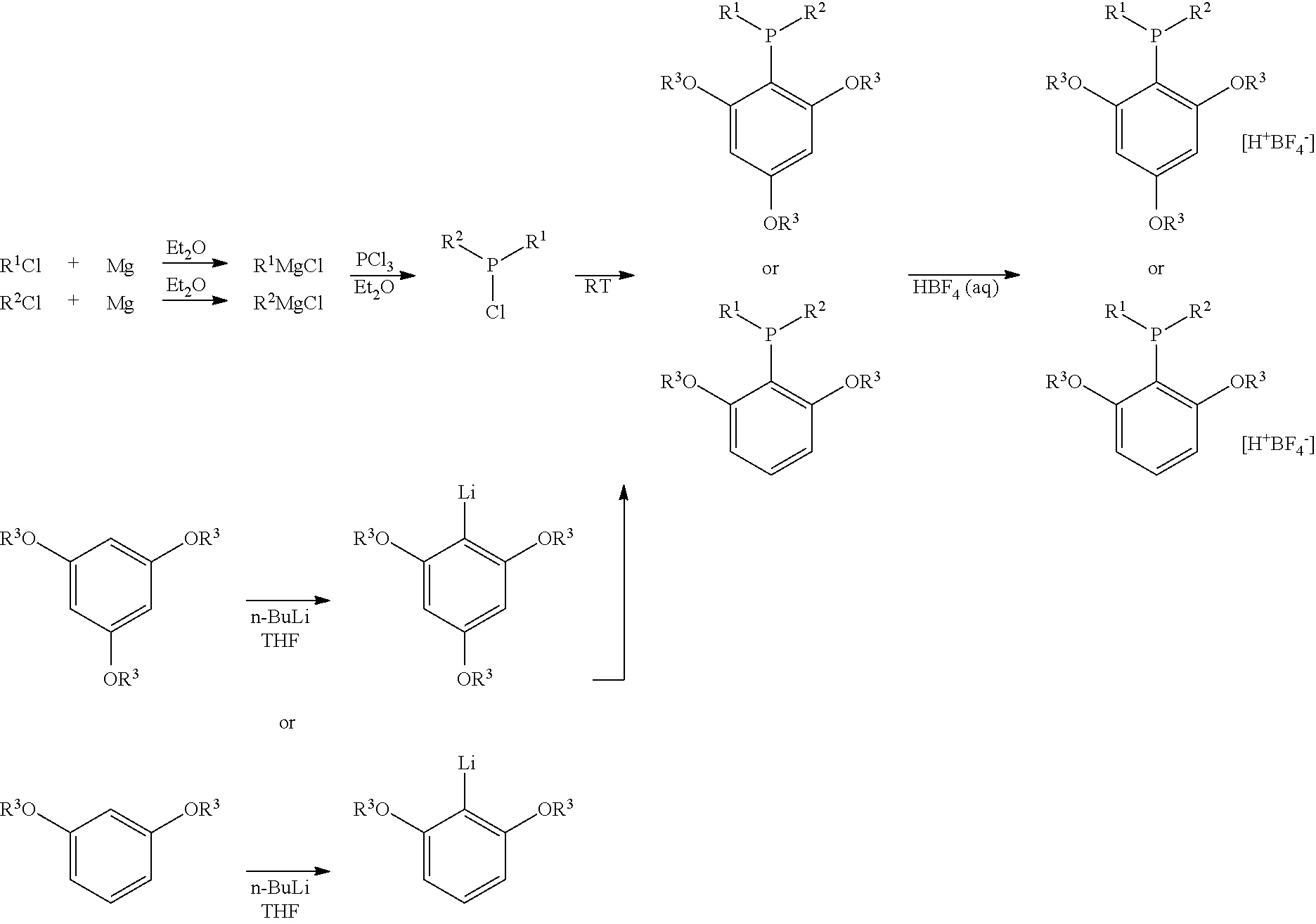Structure and method for synthesizing and using dialkyl(2,4,6- or 2,6-alkoxyphenyl)phosphine and its tetrafluoroborate
a technology of dialkyl and phosphine, which is applied in the direction of organic compounds/hydrides/coordination complexes, organic compounds/chemical process catalysts, organic compounds/chemical complexes, etc., can solve the problems of relatively active organic bromides and iodides, and achieve high research and application value and easy operation
- Summary
- Abstract
- Description
- Claims
- Application Information
AI Technical Summary
Benefits of technology
Problems solved by technology
Method used
Image
Examples
example 1
Synthesis of dicyclohexyl(2,4,6-trimethoxyphenyl)phosphine
[0026]
[0027]To a solution of trimethoxybenzene (1.0062 g, 6 mmol) in 20 mL of dry THF was added n-butyl lithium (2.6 mL, 2.5 M in hexane, 6.6 mmol) dropwise under N2. The mixture was stirred for 4.5 hours at room temperature, at which time the reaction system was then cooled to −78° C. Chlorodicyclohexyl phosphine was added dropwise. After the mixture is stirred for 30 minutes, the reaction system was warmed up to room temperature and stirred for another 18 hours. Extraction with ethyl acetate, washed with water, dried over anhydrous sodium sulfate, and purified by column chromatography (petroleum ether / ethyl acetate=10 / 1˜5 / 1) afforded 0.5514 g of product. The yield is 25%.
[0028]1H NMR (300 MHz, CDCl3) δ 6.08 (d, J=1.5 Hz, 2H). 3.81 (s, 3H), 3.77 (s, 6H), 2.30-2.16 (m, 2H), 1.92-1.54 (m, 8H), 1.48-0.90 (m, 12H); 31P NMR (121 MHz, CDCl3) δ-14.6.
example 2
Synthesis of dicyclohexyl(2,4,6-trimethoxyphenyl) phosphine tetrafluoroborate
[0029]
[0030]To a solution of trimethoxybenzene (2.0182 g, 12 mmol, 12 mmol) in 50 mL of dry THF was added n-butyl lithium (0.8 mL, 2.5 M in hexane, 12 mmol) dropwise under N2. The mixture was stirred for 11.5 hours at room temperature, at which time the reaction system was then cooled to −78° C. Chlorodicyclohexyl phosphine was added dropwise. After the mixture is stirred for 30 minutes, the temperature is warmed to room temperature and the reaction was stirred for another 18 hours.
[0031]To another dried three-neck flask was added PCl3 (0.92 mL, d=1.50 g / mL, 1.38 g, 10 mmol) and 50 mL of dry Et2O. The solution was cooled to −40° C. and cyclohexylmagnesium chloride (25 mL, 0.80 M, 20 mmol) was added dropwise at this temperature within 10 min. After the addition, the resulting mixture was allowed to stir at 30° C. for 7.4 h. The above prepared S-trimethoxyphenyl lithium solution was then added in one portion....
example 3
Synthesis of dicyclohexyl(2,6-dimethoxybiphenyl) phosphine tetrafluoroborate
[0033]
[0034]The synthesis is carried in the same manner as the method described in example 2. The difference is that: the starting material is trichlorophosphine (0.92 mL, 1.38 g, 10 mmol), cyclohexylmagnesium chloride (0.8 M in Et2O), 1,3-Dimethoxybenzene (1.60 mL, 1.68 g, 12 mmol) and n-butyl lithium (2.5 M in hexane). After the reaction is done in ether / tetrahydrofuran, tetrafluoborate aqueous solution is used to quench the reaction, and dialkyl(2,6-methoxyphenyl)phosphine tetrafluoroborate is obtained. The yield is 15%.
[0035]1H NMR (300 MHz, CDCl3) δ 7.63-7.71 (m, 1H), 6.80-6.65 (m, 2H), 6.77 (dt, J1=486 Hz, J2=6.3 Hz, 1H); 3.95 (s, 6H), 2.90-2.70 (m, 2H), 2.20-2.06 (m, 2H), 1.95-1.63 (m, 8H), 1.56-1.10 (m, 10H); 31P NMR (121 MHz, CDCl3) δ 7.36.
PUM
| Property | Measurement | Unit |
|---|---|---|
| temperature | aaaaa | aaaaa |
| temperature | aaaaa | aaaaa |
| temperature | aaaaa | aaaaa |
Abstract
Description
Claims
Application Information
 Login to View More
Login to View More - R&D
- Intellectual Property
- Life Sciences
- Materials
- Tech Scout
- Unparalleled Data Quality
- Higher Quality Content
- 60% Fewer Hallucinations
Browse by: Latest US Patents, China's latest patents, Technical Efficacy Thesaurus, Application Domain, Technology Topic, Popular Technical Reports.
© 2025 PatSnap. All rights reserved.Legal|Privacy policy|Modern Slavery Act Transparency Statement|Sitemap|About US| Contact US: help@patsnap.com



